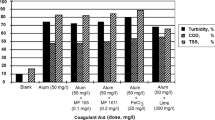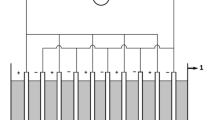Abstract
This paper investigated the effects of parameters, like inoculum size (15, 10 and 5% of the working volume of the reactor), gas velocities (0.0027, 0.00342 and 0.0068 m/s), bed heights (0.3, 0.6 and 0.9 m), static bed heights (4.85 and 2.43 cm), sizes of solid media particles (12, 4 mm), and the height to diameter ratio (H/D: 0.25 and 0.5) onto COD reduction process for electroplating effluent (initial COD values: 1140 ppm) using Pseudomonas aeruginosa and Pseudomonas putida. The authors derived simple mathematical correlations representing the entire COD reduction process. The correlation between the inoculum volume and gas velocities was in the form of an equation Y = ax2 + bx + c, as deduced from nonlinear regressions. The correlations were validated, and percentage errors were found out to infer the effects of all parameters in the COD reduction process. The maximum COD reduction was achieved to 28.30 ppm (97.52%), in a batch mode, at 10% inoculum size, 0.0027 m/s low gas velocity and a static bed height of 2.43 cm.










Similar content being viewed by others
References
Adhoum N, Monser L, Bellakhal N, Belgaied JE (2004) Treatment of electroplating wastewater containing Cu+2, Zn+2 and Cr(VI) by electrocoagulation. J Hazard Mater B 112:207–213
Al-shannag M, Al-Qodah Z, Bani-Melhem K, Qtaishat KR, Alkasrawi M (2015) Heavy metal ions removal from metal plating wastewater using electrocoagulation: kinetic study and process performance. Chem Eng J 260:749–756
Barakat MA (2011) New trends in removing heavy metals from industrial wastewater. Arab J Chem 4:361–377
Bazrafshan E, Mohammadi L, Ansari-Moghaddam A, Mahvi AH (2015) Heavy metals removal from aqueous environments by electrocoagulation process- a systematic review. J Environ Health Sci Eng 13:1–16
Dermentzis K, Christoforidis A, Valsamidou E (2011) Removal of nickel, copper, zinc and chromium from synthetic and industrial wastewater by electro coagulation. Int J Environ Sci 1:697–710
Fu F, Wang Q (2011) Removal of heavy metal ions from wastewaters: a review. J Environ Manage 92:407–418
Gallegos-Gareia M, Celis LB, Rangel-Mendez R, Razo-Flores E (2009) Precipitation and recovery of metal sulfides from metal containing acidic wastewater in a sulfidogenic down-flow fluidized bed reactor. Biotechnol Bioeng 102:91–99
Haribabu K, Sivasubramanian V (2014) Treatment of wastewater in a fluidized bed bioreactor using low density biosupport. Energy Procedia 50:214–221
Lekhlif B, Oudrhiri L, Zidane F, Drogui P, Blais JF (2014) Study of the electrocoagulation of electroplating industry wastewaters charged by nickel (II) and chromium (VI). J Mater Environ Sci 1:111–120
Mazumder D, Ghosh D, Bandyopadhyay P (2011) Treatment of electroplating wastewater by adsorption technique. Int J Civil Environ Eng 3:101–110
Naim R, Kisay L, Park J, Qaisar M, Zulfiqar AB, Noshin M, Jamil K (2010) Precipitation chelation of cyanide complexes in electroplating industry wastewater. Int J Environ Res 4:735–740
Nikolov L, Karamanev D (1987) Experimental study of inverse fluidized bed biofilm reactor. Can J Chem Eng 65:214–217
O’Connell DW, Birkinshaw C, O’Dwyer TF (2008) Heavy metal adsorbents prepared from the modification of cellulose: a review. Bioresour Technol 99:6709–6724
Park D, Yun YS, Jo JH, Park JM (2006) Biosorption process for treatment of electroplating wastewater containing Cr(VI): laboratory scale feasibility test. Ind Eng Chem Res 45:5059–5065
Peng C, Song S, Lu S, Lopez-Valdivieso A (2004) Electroplating wastewater treatment through chemical precipitation and electrodialysis. Eur J Miner Process Environ Prot 4:210–215
Praveen KC, Radha KV, Balasubramanian N (2011) Electrochemical treatment of plating effluent: kinetics and statistical correlations. Arch Environ Sci 5:17–24
Rajasimman M, Karthikeyan C (2007) Aerobic digestion of starch wastewater in a fluidized bed bioreactor with low density biomass support. J Hazard Mater 143:82–86
Rajemahadik CF, Kulkarni SV, Kulkarni GS (2013) Efficient removal of heavy metals from electroplating wastewater using electrocoagulation. Int J Sci Res Pub 3:1–5
Sabarunisha Begum S, Radha KV (2014) Hydrodynamic behavior of inverse fluidized bed biofilm reactor for phenol biodegradation using Pseudomonas fluorescens. Korean J Chem Eng 31:436–445
Sezgin N, Balkaya N (2016) Adsorption of heavy metals from industrial wastewater by using polyacrylic acid hydrogel. Desalin Water Treat 57:2466–2480
Singh V, Ram C, Kumar A (2016) Physico-chemical characterization of electroplating industrial effluents of Chandigarh and Haryana Region. J Civil Environ Eng 6:237–242
Souza RR, Barsolin ITL, Bioni TL, Gimenes ML, Dias-Filho BP (2004) The performance of a three-phase fluidized bed reactor in treatment of wastewater with high organic load. Braz J Chem Eng 21:219–227
Sur DH, Mukhopadhyay M (2017a) COD reduction of textile effluent in Three-phase fluidized bed bioreactor using Pseudomonas aureofaciens and Escherichia coli. Biotech 7(141):1–11
Sur DH, Mukhopadhyay M (2017b) Process aspects of three-phase inverse fluidized bed bioreactor: a review. J Environ Chem Eng 5:3518–3528
Tran TK, Leu HJ, Chiu KF, Lin CY (2015) Electrochemical treatment for wastewater contained heavy metal: the removing of the COD and heavy metal ions. Int J Eng Res Gen Sci 1(9):96–101
Zhao Y, Cao X (2012) Study on treatment of electroplating wastewater by UV-Fenton oxidation-biological aerated filter process. Adv Biomed Eng 6:358–362
Acknowledgements
Authors thank Gujarat Council on Science and Technology, [GUJCOST], Gandhinagar, Gujarat, India—for funding this research work (Grant ref.: GUJCOST/MRP/12-13/62/1311). Mr. Dharmesh H Sur is grateful for the support and motivation provided by the management of V V P Engineering College, Rajkot (India).
Author information
Authors and Affiliations
Corresponding author
Ethics declarations
Conflict of interest
This manuscript is the authors’ original work and has not been published nor has it been submitted simultaneously elsewhere. All authors have checked the manuscript and have agreed to the submission.
Electronic supplementary material
Below is the link to the electronic supplementary material.
Rights and permissions
About this article
Cite this article
Sur, D.H., Mukhopadhyay, M. Process parametric study for COD removal of electroplating industry effluent. 3 Biotech 8, 84 (2018). https://doi.org/10.1007/s13205-017-1059-0
Received:
Accepted:
Published:
DOI: https://doi.org/10.1007/s13205-017-1059-0




